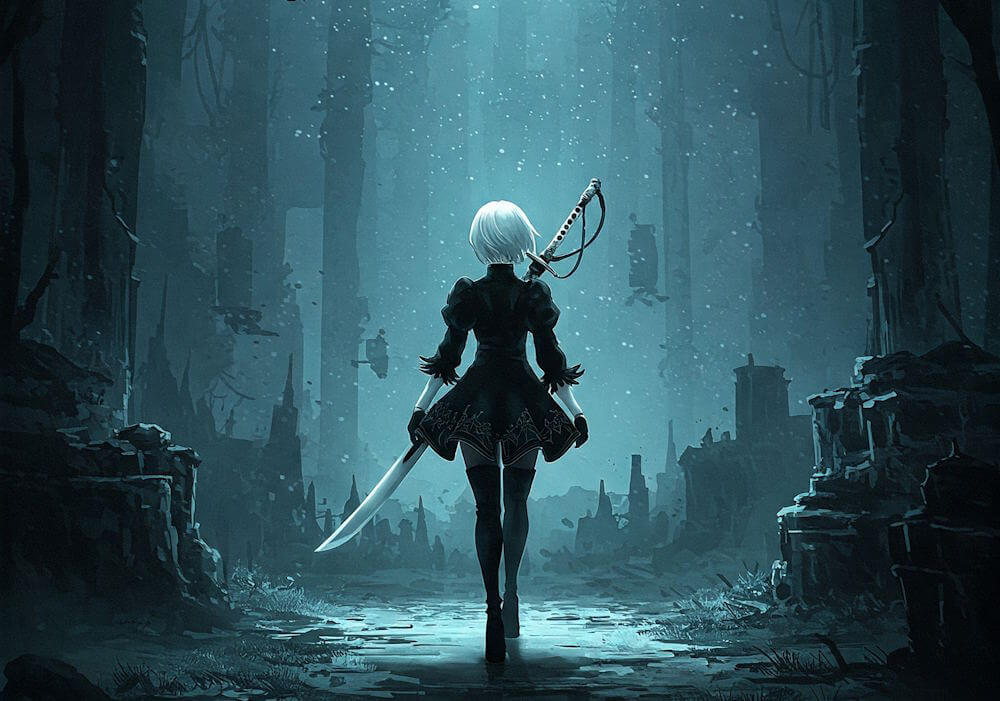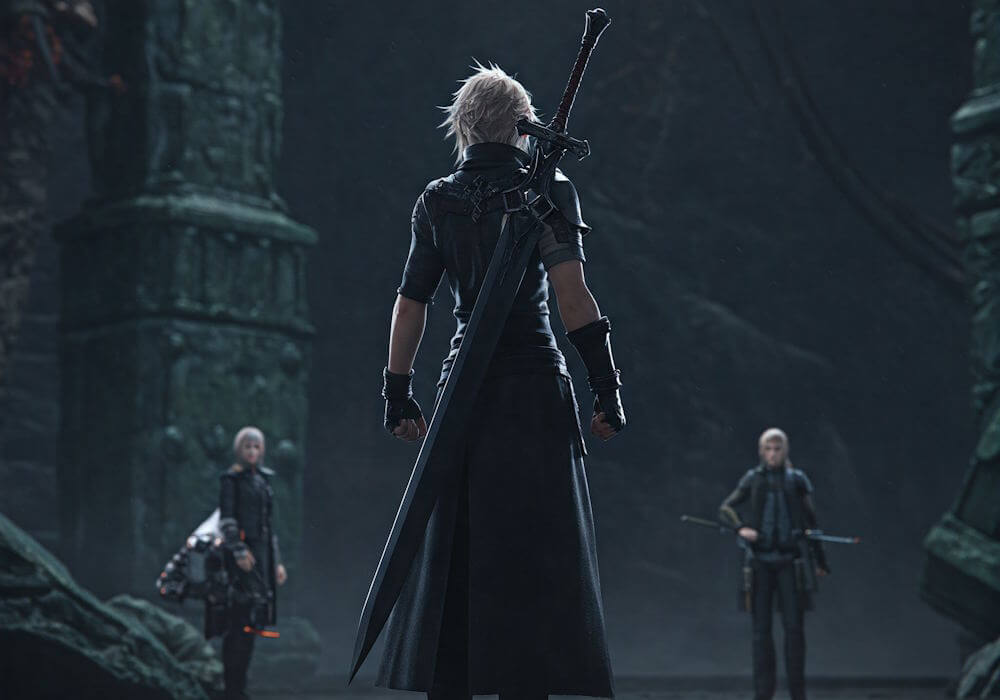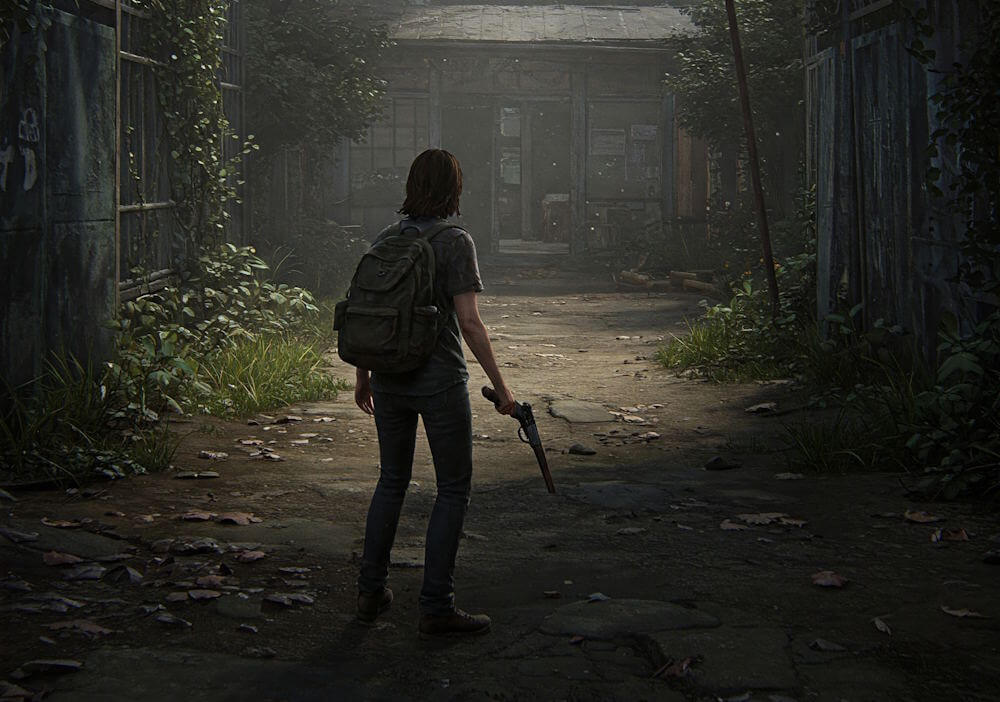‘Nier: Automata’ is a groundbreaking title released on March 7, 2017, developed by PlatinumGames and published by Square Enix. As a sequel to the original ‘Nier,’ which was itself a spin-off from the ‘Drakengard’ series, ‘Nier: Automata’ expanded the narrative universe with innovative gameplay, philosophical themes, and a compelling story. Directed by Yoko Taro, a renowned figure known for his unorthodox approach to game design and storytelling, the game showcases a visionary perspective that challenges traditional formats within the action RPG genre.
The development of ‘Nier: Automata’ began as a collaborative effort between Yoko Taro and PlatinumGames, known for their expertise in fast-paced combat systems exemplified in titles like ‘Bayonetta’ and ‘Metal Gear Rising.’ Taro’s unique storytelling style weaves deep existential questions into the fabric of the game, inviting players to reflect on themes such as consciousness, purpose, and the nature of existence. This narrative complexity sets ‘Nier: Automata’ apart from conventional RPGs, where gameplay often prioritizes mechanics over philosophical inquiry.
Moreover, the game employs a blend of genre-defying mechanics, incorporating elements from hack-and-slash fighters, platformers, and bullet hell shooters, alongside a story that unfolds through multiple playthroughs. Each run through the game reveals new perspectives and teaches players more about the intricate world of androids and their fight against alien machines, leading to a richer understanding of the overarching narrative.
‘Nier: Automata’ not only redefines expectations within the action RPG genre but also illustrates the potential for video games as a narrative medium. Its artistic approach and philosophical underpinnings have garnered critical acclaim and a devoted fanbase, establishing it as a seminal work that stands out in modern gaming culture.
Innovative Narrative Structure
‘Nier: Automata’ approaches the storytelling of the action RPG genre with a unique multi-layered narrative that revises standard conventions. Unlike typical games that often present a linear storyline, this title embraces complexity by intertwining multiple character perspectives and varied arcs. Each playable character offers a different viewpoint on the central conflict, presenting players with moral dilemmas that challenge conventional notions of good and evil. This structure urges players to engage critically with the story, reflecting on their choices as they progress through different segments of the game.
The character development in ‘Nier: Automata’ is similarly innovative, as it delves deeply into the psyches of its protagonists, particularly androids 2B, 9S, and A2. Their evolution throughout the narrative mirrors profound philosophical themes such as existentialism and the nature of consciousness. The characters grapple with questions regarding their purpose, identity, and autonomy, which invites players to reflect on these themes in relation to their own lives. This depth adds layers to the emotional impact, allowing for a richer gameplay experience that extends beyond mere combat.
Moreover, the necessity of multiple playthroughs plays a critical role in fully uncovering the game’s narrative. Each subsequent playthrough reveals new story elements, characters, and gameplay mechanics, transforming the player’s understanding of the plot and its underlying messages. The decision to structure the narrative in this manner creates a sense of engagement and investment in the overarching themes. By demanding that players return to the game repeatedly to appreciate its full scope, ‘Nier: Automata’ not only redefines the action RPG genre but also enhances the player’s emotional connection to the story.
Complex Characters and Philosophical Themes
Nier: Automata is widely recognized not only for its innovative gameplay but also for its profound exploration of complex characters and philosophical themes. Central to this narrative are the characters 2B, 9S, and A2, each embodying distinct yet interconnected attributes that contribute to the game’s emotional depth. 2B, a combat android, represents the tension between duty and emotion as she grapples with the implications of her role as a soldier. Her struggle with the expectations placed upon her illuminates the overarching theme of free will, prompting players to consider the depth of her character beyond mere functionality.
Similarly, 9S serves as a foil to 2B, characterized by his agnostic and inquisitive nature. His desire to understand his existence and the world around him drives the narrative forward. Throughout their journey, players witness the evolution of 9S from a naive companion to a character burdened by profound existential questions. This transformation engages players on an emotional level, fostering a connection that challenges them to reflect on their own purpose and humanity. The philosophical exploration of identity, morality, and the pursuit of knowledge is a recurring motif in Nier: Automata, making 9S’s journey particularly impactful.
A2, a rebellious figure with a tumultuous past, further enriches the game’s thematic fabric. Her character arc emphasizes defiance and the quest for self-identity, as she seeks redemption and agency. A2’s interactions with both 2B and 9S culminate in revelations that challenge players’ perceptions of loyalty and betrayal. This intricate web of relationships not only enhances player engagement but also prompts introspection on the nature of humanity itself.
Through these richly developed characters and the philosophical themes intricately woven into the narrative, Nier: Automata offers players an experience that transcends traditional action RPG conventions. The emotional stakes are heightened as players navigate the complexities of free will, purpose, and what it truly means to be human.
Gameplay Mechanics: Fusion of Genres
Nier: Automata stands out within the action RPG genre through its innovative gameplay mechanics that seamlessly merge multiple genres, resulting in a uniquely engaging experience for players. Central to this fusion is the implementation of hack-and-slash combat, which is both fluid and responsive. Players can execute a variety of combo attacks, utilizing different weapons to dispatch enemies with grace and power. This mechanic allows for customization in combat style, enabling players to adapt their approaches based on unique preferences.
Moreover, Nier: Automata incorporates platforming elements that enhance exploration and traverse the diverse environments within the game. Players are prompted to navigate both vertical and horizontal spaces, solving puzzles and discovering secrets that add depth to the narrative. The combination of combat and platforming not only enriches the gameplay but also keeps players invested in the unfolding storyline, as each new area presents distinct challenges and opportunities.
In addition to these mechanics, the title integrates bullet hell shooter elements that further diversify the combat experience. During certain encounters, the gameplay shifts into a top-down view, where players must dodge waves of bullets while simultaneously attacking enemies. This dynamic change in gameplay style offers a fresh perspective and intensifies the action, making encounters both exhilarating and demanding. The variability of gameplay mechanics in Nier: Automata keeps players engaged, as they must constantly adapt and refine their strategies to overcome the varied challenges presented throughout the game.
Ultimately, the combination of hack-and-slash combat, platforming sequences, and bullet hell shooter mechanics contribute to an unforgettable player experience in Nier: Automata, positioning it as a remarkable title within the action RPG genre. This multifaceted gameplay not only broadens the horizons of traditional RPG mechanics but also captivates a wide audience of gamers, encouraging both exploration and mastery.
Artistic Design and World-Building
‘Nier: Automata’ is renowned for its striking artistic design and immersive world-building, which collectively serve to enhance the overall narrative. The game’s visual style is a masterclass in blending elements of realism with a stylized aesthetic, creating an environment that feels both alien and familiar. Players traverse a post-apocalyptic world characterized by abandoned cities overtaken by nature, which subtly communicates the consequences of humanity’s absence. The juxtaposition of organic elements with robotic remnants conveys a profound message about the cycle of life and death.
Environmental storytelling is a hallmark of ‘Nier: Automata’, as players encounter remnants of past civilization, such as crumbling skyscrapers and dormant machinery, that echo the game’s overarching themes. The world is rich with detail, encouraging exploration while provoking thoughtful reflection on the narrative’s philosophical questions. Every location, from the desolate landscapes to the urban ruins, is meticulously crafted, allowing players to glean insights into the history of the setting without the need for explicit exposition. This design choice fosters a deeper emotional connection to the characters and their journey.
Additionally, the contribution of music and sound design in ‘Nier: Automata’ cannot be understated. The soundtrack, composed by Keiichi Okabe, complements the visual elements perfectly, enhancing the atmospheric experience. Melodies blend beautifully with soundscapes, creating an immersive backdrop that captures the essence of each environment. The use of sound effects further amplifies key moments in gameplay, drawing players into the emotional weight of their decisions. Thus, the convergence of artistic design, environmental storytelling, and auditory experience sets ‘Nier: Automata’ apart, solidifying its position as a benchmark in the action RPG genre.
Emotional Impact and Player Experience
‘Nier: Automata’ stands out within the action RPG genre due to its profound emotional resonance, which significantly shapes the player’s journey. The game intricately weaves together a narrative that delves into existential themes such as identity, purpose, and the human condition. Through its compelling storytelling, it invites players to engage not just with the gameplay mechanics but also with the philosophical dilemmas presented throughout the experience. This dual engagement fosters a more immersive environment, wherein players find themselves deeply invested in the outcomes of the characters they control.
Key moments within the game provoke a spectrum of emotions, from joy and hope to despair and loss. The relationships between characters such as 2B, 9S, and A2 are rich and multifaceted, showcasing a layered emotional depth that encourages players to empathize with their struggles. For instance, players might feel a sense of betrayal or grief during particularly poignant narrative arcs, prompting reflections on loyalty and sacrifice. This emotional engagement is further enhanced by the game’s atmospheric score and beautifully crafted visuals, which together create a truly unforgettable experience.
The balance struck between gameplay and storytelling in ‘Nier: Automata’ is instrumental in delivering this emotional impact. Players are not merely passive recipients of a story; rather, they actively participate in the unfolding drama, influencing outcomes through their choices and actions. This interactivity reinforces the weight of decisions, making each moment resonate more profoundly. As players navigate through the multiple endings, each revelation leads to an evolving understanding of the game’s themes, thereby deepening their emotional connection. Ultimately, ‘Nier: Automata’ exemplifies how an action RPG can transcend traditional genre boundaries by prioritizing player emotional experience alongside dynamic gameplay.
Reception and Cultural Impact
‘Nier: Automata’ has experienced remarkable acclaim since its release in March 2017. The critical reception was overwhelmingly positive, with numerous reviewers praising its intricate narrative, compelling characters, and innovative gameplay mechanics. Major gaming publications and platforms often awarded it top scores, which are indicative of its high-quality production and engaging experience. Among its recognition, ‘Nier: Automata’ garnered several prestigious awards, including the award for Best Game Direction at The Game Awards 2017, and it was nominated for Game of the Year by various outlets. Such accolades reflect the game’s significant craftsmanship and artistic vision.
Commercially, ‘Nier: Automata’ has also proven to be a success. The game sold over five million copies worldwide within a few years, a substantial achievement for a title from a franchise that previously had a niche following. This level of success has contributed to a resurgence of interest in the series, leading to increased sales for its predecessor, ‘Nier,’ along with a broader interest in the action RPG genre as a whole. The success of ‘Nier: Automata’ has encouraged publishers and developers to invest in more narrative-driven experiences within the action RPG framework, which might have been less prioritized prior to its release.
The cultural impact of ‘Nier: Automata’ extends beyond just sales and awards. It has sparked extensive discourse within the gaming community and prompted analyses regarding its philosophical themes, emotional depth, and existential inquiries. The game’s unique approach to storytelling—where player choices significantly alter narrative outcomes—has influenced game design and narrative structures in subsequent titles. Moreover, ‘Nier: Automata’ has inspired fan art, merchandise, and even academic discussions, solidifying its position as not just a game, but a cultural phenomenon that challenges traditional gaming narratives and expectations.
Comparisons with Other Action RPGs
When exploring the landscape of action role-playing games, it becomes evident that each title contributes uniquely to the genre. “Nier: Automata” stands out through an intricate blend of storytelling, gameplay mechanics, and character development that contrasts sharply with several notable titles within the same category. While many action RPGs, such as “The Witcher 3” and “Dark Souls,” prioritize expansive worlds and linear questlines, “Nier: Automata” challenges these conventions with its thought-provoking narrative and complex themes that often delve into existentialism and the nature of consciousness.
One of the key differences lies in the storytelling approach. “The Witcher 3,” for example, employs a traditional fantasy setting filled with rich lore and character arcs often heavily influenced by player choices. In contrast, “Nier: Automata” presents a more fragmented storytelling technique through multiple playthroughs, thereby inviting players to piece together a larger narrative puzzle. This unique structure not only enhances replayability but also encourages players to engage deeply with characters, such as 2B and 9S, whose complexities evolve throughout the game.
Gameplay mechanics further distinguish “Nier: Automata” from its peers. Many action RPGs tend to emphasize combat systems that focus on character progression through gear and abilities, whereas “Nier: Automata” integrates various gameplay styles, including third-person shooter elements and hack-and-slash attacks. This fluidity allows for a dynamic combat experience that is less linear and caters to diverse player preferences. Moreover, character development diverges from the typical leveling systems found in other RPGs, as weapons and skills can be customized extensively, granting players the freedom to create their unique playstyles.
In reflecting on these comparisons, it is clear that “Nier: Automata” redefines action RPGs by innovating in storytelling, gameplay, and character dynamics, setting new benchmarks that resonate throughout the gaming industry.
Conclusion: The Legacy of Nier: Automata
The legacy of ‘Nier: Automata’ extends far beyond its gameplay mechanics and aesthetics; it serves as a pivotal point in the evolution of the action RPG genre. One of the most significant contributions of this game is its ability to intertwine gameplay with narrative, creating a seamless experience where players are not mere participants but active players in a moral and philosophical discourse. By embedding themes of existentialism, consciousness, and the human condition, ‘Nier: Automata’ challenges players to confront their own beliefs and values, elevating the storytelling in video games to new heights.
Moreover, the design choices within the game, including multiple endings and non-linear storytelling, allow players to engage with the content on a profound level, resulting in a tailored experience that is both personal and universal. This aspect encourages reflective gameplay, prompting players to consider the weight of their decisions, thus reinventing the dynamics of player agency within the action RPG framework. The innovative mechanics presented challenge traditional notions of gameplay, inviting other developers to reconsider how narratives can be integrated into game design.
In addition, the influence of ‘Nier: Automata’ has permeated the gaming industry, inspiring a new generation of developers to experiment with complex narratives and emotionally charged themes. The game has set a precedent for what action RPGs can achieve, pushing the boundaries of storytelling and character development. Its unique blend of action, philosophy, and art has solidified ‘Nier: Automata’ as a benchmark for future titles in the genre. As we reflect on its impact, it is clear that ‘Nier: Automata’ has redefined expectations of action RPGs, paving the way for more ambitious and meaningful experiences in the realm of video gaming.




